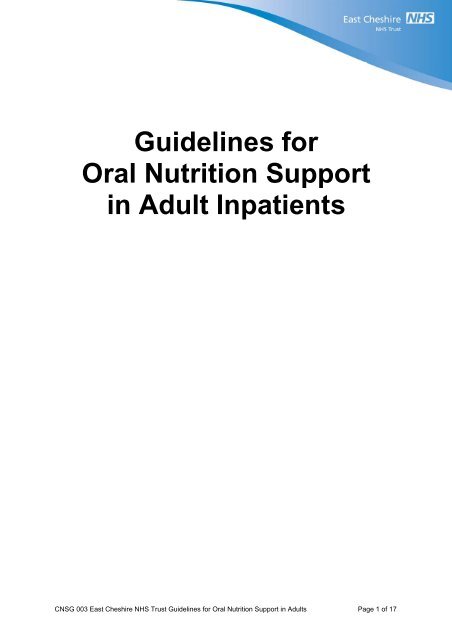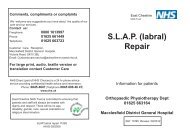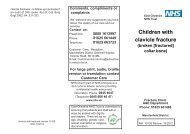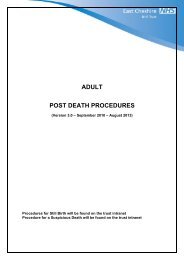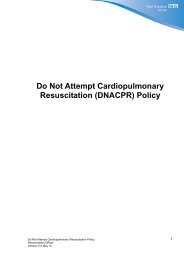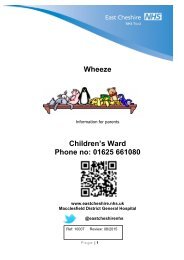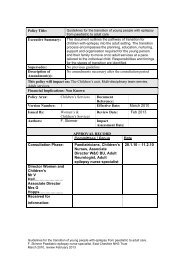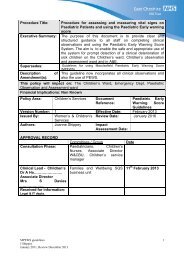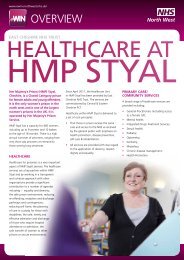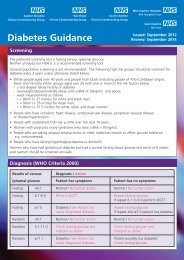Guidelines for oral nutrition support - East Cheshire NHS Trust
Guidelines for oral nutrition support - East Cheshire NHS Trust
Guidelines for oral nutrition support - East Cheshire NHS Trust
Create successful ePaper yourself
Turn your PDF publications into a flip-book with our unique Google optimized e-Paper software.
<strong>Guidelines</strong> <strong>for</strong>Oral Nutrition Supportin Adult InpatientsCNSG 003 <strong>East</strong> <strong>Cheshire</strong> <strong>NHS</strong> <strong>Trust</strong> <strong>Guidelines</strong> <strong>for</strong> Oral Nutrition Support in Adults Page 1 of 17
Policy Title:ExecutiveSummary:Supersedes:Description ofAmendment(s):<strong>Guidelines</strong> <strong>for</strong> Oral Nutrition Support in Adult InpatientsTo provide evidence-based guidance <strong>for</strong> the use of food <strong>for</strong>tificationand <strong>oral</strong> <strong>nutrition</strong>al supplements <strong>for</strong> adult inpatients under the careof <strong>East</strong> <strong>Cheshire</strong> <strong>NHS</strong> <strong>Trust</strong>.New <strong>Guidelines</strong>New <strong>Guidelines</strong>This policy will impact on:All staff caring <strong>for</strong> adult patients under the care of <strong>East</strong> <strong>Cheshire</strong> <strong>NHS</strong> <strong>Trust</strong> (ECT).Financial Implications:Appropriate, timely and cost-effective <strong>oral</strong> <strong>nutrition</strong>al <strong>support</strong> should improve <strong>nutrition</strong>al careand reduce costs and risks associated with sub-optimal patient <strong>nutrition</strong>.Policy Area: <strong>Trust</strong> Wide Document Reference: CNSG003Version Number: 1 Effective Date: 1 st July 2011Issued By:Kath Senior, ExecutiveDirector of Nursing,Per<strong>for</strong>mance & QualityReview Date: 1 st July 2013Authors:Amanda Hamilton(Specialist Dietitian)Impact AssessmentDate:1 st July 2013APPROVAL RECORDConsultation:Approved by Director:Received <strong>for</strong> in<strong>for</strong>mation:Committees / GroupDateClinical Nutrition Steering Group 31 st March 2011 &14 th June 2011Matrons and Departments of: 2009-2010 Nutrition and Dietetics Pharmacy Catering & Supplies Speech & Language TherapyMedicines Management Group April/May 2011Kath Senior<strong>Trust</strong> Quality Strategy GroupCNSG 003 <strong>East</strong> <strong>Cheshire</strong> <strong>NHS</strong> <strong>Trust</strong> <strong>Guidelines</strong> <strong>for</strong> Oral Nutrition Support in Adults Page 2 of 17
CONTENTSPAGES1.0 INTRODUCTION 42.0 AIMS 43.0 ORGANISATIONAL RESPONSIBILITIES 53.1 Medical Staff3.2 Dietitians3.3 Matrons and Ward Managers3.4 Ward Pharmacists3.5 Catering & Supplies Departments3.6 Speech & Language Therapists4.0 SNACKS AND “OUT OF HOURS” MEAL PROVISION 65.0 FOOD FORTIFICATION 66.0 PRESCRIBABLE ORAL NUTRITIONAL SUPPLEMENTS 6-77.0 PROCEDURE FOR PATIENTS REQUIRING PRESCRIBABLE ORALNUTRITIONAL SUPPLEMENTS ON DISCHARGE FROM HOSPITAL 78.0 REFERENCES & RELATED DOCUMENTS 89.0 APPENDICES 9-121 Procedure <strong>for</strong> Ordering Prescribable Oral NutritionSupplements and Enteral Feeds <strong>for</strong> Adult Wards2 Oral Nutritional Supplements used <strong>for</strong> Inpatients at ECT3 How to Store & Use Oral Nutritional Supplements10.0 EQUALITY & HUMAN RIGHTS IMPACT ASSESSMENT FORM 13-17CNSG 003 <strong>East</strong> <strong>Cheshire</strong> <strong>NHS</strong> <strong>Trust</strong> <strong>Guidelines</strong> <strong>for</strong> Oral Nutrition Support in Adults Page 3 of 17
1.0 INTRODUCTIONAll clinical staff at <strong>East</strong> <strong>Cheshire</strong> <strong>NHS</strong> <strong>Trust</strong> (ECT) have a crucial role to play in achievingand maintaining good <strong>nutrition</strong>al care.Mal<strong>nutrition</strong> (under-<strong>nutrition</strong>) can adversely affect every system in the body. Many patientscoming into hospital are able to drink normally and manage a normal diet during theirhospital stay. Patients identified as “at high” risk of mal<strong>nutrition</strong>, with a MUST (Mal<strong>nutrition</strong>Universal Screening Tool) score of 2 or above, will require <strong>nutrition</strong> <strong>support</strong> to help to meettheir <strong>nutrition</strong>al requirements. Randomised controlled studies and meta-analyses suggestthat <strong>nutrition</strong> <strong>support</strong> of undernourished individuals can reduce mortality, complications afterillness, length of hospital stay, re-admission rates to hospital and costs of care, and alsoimprove well being. 1,2,3Nutrition <strong>support</strong> can be provided by the following: Food <strong>for</strong>tification and use of snacks Use of <strong>oral</strong> <strong>nutrition</strong>al supplements, some of which are prescribable Enteral tube feeding Parenteral <strong>nutrition</strong>Food is the simplest <strong>for</strong>m of <strong>nutrition</strong>al intervention and should always be used first.Oral <strong>nutrition</strong> <strong>support</strong> (food <strong>for</strong>tification, snacks, supplements) is the first-line “treatment” <strong>for</strong>those at risk of mal<strong>nutrition</strong> and should always be considered be<strong>for</strong>e enteral tube feeding orparenteral <strong>nutrition</strong>.2.0 AIMSThe aim is to provide evidence-based guidance <strong>for</strong> the use of food <strong>for</strong>tification and <strong>oral</strong><strong>nutrition</strong>al supplements <strong>for</strong> adult inpatients under the care of health care professionalsworking in ECT.3.0 ORGANISATIONAL RESPONSIBILITIESThe Executive Director of Nursing, who is a member of the <strong>Trust</strong> Board, has overallresponsibility <strong>for</strong> the provision of <strong>nutrition</strong> within ECT. The Clinical Nutrition Steering Group(CNSG) is responsible <strong>for</strong> the oversight of all aspects of <strong>nutrition</strong> within ECT and is currentlyaccountable to the Quality Strategy Steering Group, which is in turn accountable to the <strong>Trust</strong>Board via the Safety and Quality Standards Committee (SQS). For further in<strong>for</strong>mationregarding the role and responsibility of the CNSG in the provision of <strong>nutrition</strong>, refer to the<strong>East</strong> <strong>Cheshire</strong> <strong>NHS</strong> <strong>Trust</strong> Nutrition Policy <strong>for</strong> in-patients (CNSG001).All clinical service team managers are responsible <strong>for</strong> ensuring compliance with thisguidance within their unit/team and that staff are competent and attend appropriate training.Certain professional groups and departments have specific responsibilities.CNSG 003 <strong>East</strong> <strong>Cheshire</strong> <strong>NHS</strong> <strong>Trust</strong> <strong>Guidelines</strong> <strong>for</strong> Oral Nutrition Support in Adults Page 4 of 17
3.1 Medical Staff are responsible <strong>for</strong>: Encouraging an awareness of the benefits of appropriate <strong>nutrition</strong>al managementand treatment be<strong>for</strong>e, during and after hospital admission. Considering <strong>oral</strong> <strong>nutrition</strong>al supplements as part of the appropriate <strong>nutrition</strong>almanagement to prevent or treat mal<strong>nutrition</strong>.Ensuring that <strong>oral</strong> <strong>nutrition</strong>al supplements are correctly prescribed and monitored aspart of the patient’s <strong>nutrition</strong>al care plans during admission and on discharge.3.2 Dietitians are responsible <strong>for</strong>:Assessing each patient’s <strong>nutrition</strong>al requirements and making any recommendations<strong>for</strong> use of <strong>oral</strong> <strong>nutrition</strong>al supplements as part of his/her <strong>nutrition</strong>al care plan.Writing any recommended prescribable <strong>oral</strong> <strong>nutrition</strong> supplements on inpatient drugcharts, according to the procedure agreed with the Medicines Management Group.Requesting that the patient’s general practitioner prescribes any recommended <strong>oral</strong><strong>nutrition</strong>al supplements <strong>for</strong> patients discharged into the community, as part of theiron-going <strong>nutrition</strong>al care plan, with guidance as to time span and review frequency.Ensuring appropriate <strong>nutrition</strong>al, anthropometric and clinical monitoring of the patientin hospital and in the community if required. Delivering education and training programmes <strong>for</strong> staff relating to the use of <strong>oral</strong><strong>nutrition</strong>al supplements in patient care.3.3 Matrons and Ward Managers are responsible <strong>for</strong> ensuring that: Patients are screened <strong>for</strong> the risk of mal<strong>nutrition</strong> using the Mal<strong>nutrition</strong> UniversalScreening Tool (MUST) on admission and weekly thereafter.Nursing staff refer patients identified at risk of mal<strong>nutrition</strong> (MUST score of 2 or more)to the Department of Nutrition and Dietetics.Ordering, stock control and storage of <strong>oral</strong> <strong>nutrition</strong>al supplements is satisfactory.Ward staff are appropriately trained in the use of <strong>oral</strong> <strong>nutrition</strong>al supplements.Prescribable <strong>oral</strong> <strong>nutrition</strong> supplements are correctly given.3.4 Ward Pharmacists are responsible <strong>for</strong>:Ensuring that prescribable <strong>oral</strong> <strong>nutrition</strong>al supplements are correctly prescribed andthat any drug/nutrient interactions are identified.3.5 The Catering and Supplies Departments are responsible <strong>for</strong>Providing menus with a variety of choices at each mealtime, to include High Energy.Providing appropriate high calorie snacks.Using <strong>oral</strong> <strong>nutrition</strong>al supplements to <strong>for</strong>tify meals as directed by the Department ofNutrition and Dietetics.Co-ordinating the ordering and supply of <strong>oral</strong> <strong>nutrition</strong>al supplements from contractedsuppliers and/or wholesalers in a cost-effective and timely manner.3.6 Speech & Language Therapists are responsible <strong>for</strong>:Providing guidance to ward staff regarding thickening of <strong>oral</strong> <strong>nutrition</strong>al supplementsto the recommended consistency <strong>for</strong> patients who have swallowing problems.CNSG 003 <strong>East</strong> <strong>Cheshire</strong> <strong>NHS</strong> <strong>Trust</strong> <strong>Guidelines</strong> <strong>for</strong> Oral Nutrition Support in Adults Page 5 of 17
4.0 SNACKS AND “OUT OF HOURS” MEAL PROVISIONThe <strong>NHS</strong> Plan (DoH, 2000) was devised to improve patients’ access to good quality foodand to improve its provision and presentation at ward level.The Catering Department is open from 0700 to 1800 daily. However, outside these hours,a snack box is available (accessible via the porters) <strong>for</strong> patients who have missed meals.Snacks are available at ward level and include milky drinks, biscuits, toast and Build-Up(non-prescribable supplement). Other snacks are at the discretion of the ward manager.Patients at high risk of mal<strong>nutrition</strong> who are under the care of the Nutrition and DieteticsDepartment will receive snacks between meals, including appropriate snacks <strong>for</strong> patients ontherapeutic diets (e.g. gluten-free, texture-modified).5.0 FOOD FORTIFICATIONFood <strong>for</strong>tification is a key part of <strong>oral</strong> <strong>nutrition</strong> <strong>support</strong> and is done by enriching existingmenu items acceptable to patients to improve the <strong>nutrition</strong>al profile. Fortification can bedone using food products such as butter, cream, milk powder and with prescribableborderline substances (see section 5.0). Items suitable <strong>for</strong> <strong>for</strong>tification include orange juice,porridge, soup, milk puddings, yoghurt, texture-modified meals and mashed potato.Patients requiring food <strong>for</strong>tification are identified by ward dietitians during <strong>nutrition</strong>alassessment and the requirement <strong>for</strong> a <strong>for</strong>tified “supplemented” diet is recorded at ward leveland in the Catering Department.The menus of patients requiring a supplemented diet are identified and amended by thedietetic assistant or designated person checking the menus, who highlights the items chosen<strong>for</strong> <strong>for</strong>tification and collates the figures <strong>for</strong> the Catering Department.The diet chef <strong>for</strong>tifies the number of items required using standard recipes calculated by theDietetics Department.The highlighted menus are visible on the service belt and the supplemented items preparedare placed on the tray <strong>for</strong> the named patient <strong>for</strong> transport to the wards.6.0 PRESCRIBABLE ORAL NUTRITIONAL SUPPLEMENTSIn certain conditions some foods have characteristics of drugs and the Advisory Committeeon Borderline Substances (ACBS) advises as to the circumstances in which suchsubstances may be regarded as drugs. More details are given in section A7 of the BritishNational Formulary. Prescribable products used at ECT to <strong>for</strong>tify food are on the ACBS list.Prescribable <strong>oral</strong> <strong>nutrition</strong>al supplements are ordered, stored and managed by wards atMacclesfield, Congleton & Knuts<strong>for</strong>d hospitals. Each ward should have a designatedindividual responsible <strong>for</strong> this task, who should liaise with the Supplies and DieteticsDepartments. The procedure <strong>for</strong> ordering feed and supplements is outlined in Appendix 1.Certain borderline substances are also ordered by the Catering Department from theSupplies Department and from the collated figures wards can be recharged <strong>for</strong> the productsused at the end of each month.CNSG 003 <strong>East</strong> <strong>Cheshire</strong> <strong>NHS</strong> <strong>Trust</strong> <strong>Guidelines</strong> <strong>for</strong> Oral Nutrition Support in Adults Page 6 of 17
The range of <strong>nutrition</strong>al supplements that are stocked at ECT is listed in Appendix 2. Someare <strong>nutrition</strong>ally complete and can be used as a sole source of <strong>nutrition</strong>, while others areused to supplement an inadequate <strong>oral</strong> intake. It is essential that the patient’s total intake isa balance of protein, energy, fibre, electrolytes and vitamins and minerals (NICE guidanceCG032) 4 and this should always be considered when supplements are prescribed.The use of <strong>oral</strong> <strong>nutrition</strong>al supplements should be restricted to those patients who are unableto meet their <strong>nutrition</strong>al requirements despite the use of high calorie & protein foods and food<strong>for</strong>tification. 4 Supplements can be used inappropriately leading to clinical risk and also highlevels of wastage with cost implications,Nutritional supplements should be given under the direction and supervision of a doctor ordietitian, who will write the appropriate product and dosage on the drug chart.If a patient is admitted on supplements not stocked by ECT, the Dietetics Department shouldbe contacted <strong>for</strong> advice about appropriate alternatives or obtaining the supplement.Supplements should not be given unless accurately written on the drug chart and signed <strong>for</strong>by a trained member of staff.Oral <strong>nutrition</strong>al supplements should be thickened to the recommended consistency asadvised by the Speech & Language Therapy Department <strong>for</strong> those patients that areidentified as having swallowing problems.Unopened supplements should be stored in a cool dry place between 5 ºC and 25ºC. Onceopened, supplements should be stored according to the guidance outlined in Appendix 3.7.0 PROCEDURE FOR PATIENTS REQUIRING PRESCRIBABLE ORALNUTRITIONAL SUPPLEMENTS ON DISCHARGE FROM HOSPITALOn discharge, patients should be given 7 days supply of the <strong>oral</strong> <strong>nutrition</strong>al supplements thatthey require, from ward stock. Oral <strong>nutrition</strong>al supplements should not be listed specificallyas medications <strong>for</strong> discharge on the Electronic Discharge Notification Form (EDNF), butshould be included as “ward supplies”. If the patient is assessed as not requiring <strong>oral</strong><strong>nutrition</strong>al supplements on discharge, the dietitian will write “Not <strong>for</strong> TTO’s” in the instructionbox on the drug chart.While inpatients will be started on <strong>oral</strong> <strong>nutrition</strong>al supplements supplied by the company thatholds the ECT contract <strong>for</strong> them, these supplements should be reviewed be<strong>for</strong>e discharge toensure that <strong>nutrition</strong> <strong>support</strong> in the community is provided in the most cost-effective way.Where appropriate, the ward dietitian should give samples of <strong>oral</strong> <strong>nutrition</strong>al supplementsthat are more cost-effective <strong>for</strong> use in the community to the patient, who will be able to trialthese samples on discharge. If well tolerated, further supplies of these supplements canthen be requested from his/her general practitioner on prescription after discharge.For all patients who require prescribable <strong>oral</strong> <strong>nutrition</strong>al supplements as part of their ongoing<strong>nutrition</strong>al care plan after discharge, the dietitian will request a prescription from his/hergeneral practitioner using a standard prescription request letter. This will provide in<strong>for</strong>mationregarding the supplement(s) required and patient follow up plan.CNSG 003 <strong>East</strong> <strong>Cheshire</strong> <strong>NHS</strong> <strong>Trust</strong> <strong>Guidelines</strong> <strong>for</strong> Oral Nutrition Support in Adults Page 7 of 17
Patients in the community are followed up by the acute unit dietitians at the MacclesfieldDGH outpatient department or by general practice dietitians. No community dietetic serviceis currently provided in <strong>East</strong>ern <strong>Cheshire</strong> <strong>for</strong> patients who are housebound or living inresidential care establishments, but in 2008 the dietetic service developed an algorithm <strong>for</strong>their <strong>nutrition</strong>al management <strong>for</strong> care establishment staff and general practitioners to follow.Additionally, in collaboration with the Medicines Management Team, the dietetic service:has developed, and regularly reviews, guidance on prescribing <strong>oral</strong> <strong>nutrition</strong>alsupplements <strong>for</strong> general practitioners; and has contributed to the traffic light <strong>for</strong>mulary and script switch to <strong>support</strong> ongoingcost-effective prescribing of <strong>oral</strong> <strong>nutrition</strong>al supplements in the community.8.0 REFERENCES1. Edington J, Kon P, Martyn CN. Prevalence of mal<strong>nutrition</strong> after major surgery.Journal of Human Nutrition and Dietetics 1997; 10: 111-116.2. Green C. Existence, causes and consequences of disease related mal<strong>nutrition</strong> in thehospital and the community and clinical and financial benefits of <strong>nutrition</strong>alintervention. Clinical Nutrition 1999; 18 (Supplement 2): 3-28.3. Stratton RJ, Green CJ, Elia M Disease-related mal<strong>nutrition</strong>. An evidence basedapproach to treatment. Ox<strong>for</strong>d: CABI Publishing (CAB International), 2003.4. National lnstitute <strong>for</strong> Health and Clinical Excellence (NICE). CG032: Nutrition Supportin Adults, 2006.CNSG 003 <strong>East</strong> <strong>Cheshire</strong> <strong>NHS</strong> <strong>Trust</strong> <strong>Guidelines</strong> <strong>for</strong> Oral Nutrition Support in Adults Page 8 of 17
9.0 APPENDICESAppendix 1Procedure <strong>for</strong> Ordering Prescribable Oral Nutrition Supplements and EnteralFeeds <strong>for</strong> Adult Wards at Macclesfield, Knuts<strong>for</strong>d and Congleton Hospitalsa) AIMTo ensure that all staff are aware of how to order enteral feeds, giving sets and prescribable<strong>nutrition</strong>al supplements and that there are adequate stocks <strong>for</strong> all patients.b) ORDERING PROCEDURECurrently enteral feeding products are obtained through the Supplies Department (notPharmacy). There are 2 order <strong>for</strong>ms:(i)(ii)Abbott Requisition Form – this is used to order products from Abbott, who hold thecontract, including feeding equipment such as giving sets and feed reservoirs.Non-Abbott Requisition Form – this is used to order all other specialised feeds andONSP. The more common items are listed on the <strong>for</strong>m. No other products can beordered unless requested by the Dietetics Department.The Blank Requisition Forms are to be kept in a file marked FEED AND SUPPLEMENTORDERING.The stock levels should be checked weekly and orders placed if needed by 1200 midday onTuesdays. This is done by faxing the requisition to Supplies (fax number 3091).Patients discharged on prescribable <strong>oral</strong> <strong>nutrition</strong> supplements or enteral feeds will need totake seven days supply from ward stock.c) CHECKING ORDERSWhen products are received onto the ward refer to the order <strong>for</strong>m to check that the order iscorrect e.g. all the products ordered have arrived and the correct giving sets have been sent.“Build Up” is non-prescribable and is obtained from <strong>NHS</strong> Logistics.CNSG 003 <strong>East</strong> <strong>Cheshire</strong> <strong>NHS</strong> <strong>Trust</strong> <strong>Guidelines</strong> <strong>for</strong> Oral Nutrition Support in Adults Page 9 of 17
Appendix 2Oral Nutritional Supplements used <strong>for</strong> Inpatients at ECTEnsure Plus Milkshake Style Prescribable Milkshake style – best served chilled Various flavours – vanilla/strawberry most popular Nutritionally complete – in 5 bottles Each bottle contains 330 Kcals and 14g protein Can be thickened with care Similar products include Fortisip, Fresubin Energy drinkAbbottEnsure Plus Yoghurt Style Prescribable Yoghurt style – best served chilled – No pro-biotic action Flavours include strawberry swirl and pineapple twist Nutritionally complete – in 5 bottles Similar products include FortifreshAbbottEnsure Plus Juce (Formerly Enlive Plus) Prescribable Fruit juice style – best served chilled Various flavours – lemon & lime are most popular Fat free NOT <strong>nutrition</strong>ally complete Each bottle contains 330 Kcals and 11g protein Very difficult to thicken Similar products include Fortijuce, Provide ExtraAbbottEnsure Plus Créme Prescribable Pudding style supplement Four flavours Nutritionally complete Each pot gives 171 Kcals and 7 g protein ‘Custard ’consistency Similar products include Forticreme CompleteAbbottEnsure Plus With Fibre (Formerly Enrich Plus) Prescribable Ensure Plus with added fibre Each bottle gives 5g fibre, 305 Kcals and 12.5g protein Slightly thicker than Ensure Plus Similar products include Fortisip Multifibre, Fresubin Energy FibreAbbottEnsure Twocal• Prescribable• Each carton given 400 Kcalories and 17g protein• Nutritionally complete in two cartons• Slightly thicker than Ensure PlusAbbottCNSG 003 <strong>East</strong> <strong>Cheshire</strong> <strong>NHS</strong> <strong>Trust</strong> <strong>Guidelines</strong> <strong>for</strong> Oral Nutrition Support in Adults Page 10 of 17
Appendix 3How to Store & Use Oral Nutritional SupplementsUnopened supplements should be stored in a cool (5-25 o C) dry place. Some, e.g.Ensure Plus and Ensure Plus Juce, are more palatable if served chilled from the Wardfridge.Always check the 'best be<strong>for</strong>e' date be<strong>for</strong>e using.Once opened items should be labelled with the patient’s name. The following guidelinesshould be followed:Product Label required Once opened usewithinAdditionalin<strong>for</strong>mationCalogen Date 14 days Must be stored inward drugs fridgeEnsure Plus Date and time 4 hoursEnsure PlusFibreEnsure PlusJuceEnsure PlusCremeDate and timeDate and timeDate and time4 hours4 hours4 hoursEnsure Twocal Date and time 4 hoursNepro Date and time 4 hoursMaxijul Powder Date 1 monthProcal Date 1 month <strong>for</strong> TubSingle use <strong>for</strong> SachetScandishake/EnshakeBuild-UpDate and timeWhen made up: 4 hours at roomtemperature24 hours in fridgeStore in ward foodfridge in coveredjug/beakerOpened sachet: 2 daysOpened sachet incool, dry place.Thickener andthickeneddrinksDate and timeWhen made up: 4 hours at roomtemperatureFor supplements not listed please refer to manufacturer's in<strong>for</strong>mation or dietetic instruction.CNSG 003 <strong>East</strong> <strong>Cheshire</strong> <strong>NHS</strong> <strong>Trust</strong> <strong>Guidelines</strong> <strong>for</strong> Oral Nutrition Support in Adults Page 12 of 17
10.0 EQUALITY & HUMAN RIGHTS IMPACT ASSESSMENT FORMPart 1 – AIMS AND IMPLEMENTATION OF THE POLICY1.1 What is being assessed? Name of the policy, procedure, strategy or servicespecification (from now on referred to as ‘DOCUMENT’):<strong>Guidelines</strong> <strong>for</strong> Oral Nutrition Support in Adult Inpatients, CNSG0031.2 Details of person responsible <strong>for</strong> completing the assessment: Name: Dr. David Alan OLEESKY Job title: Consultant Chemical Pathologist and Chairman of CNSG until 31/3/2011 Team: Clinical Nutrition Steering Group (CNSG)1.3 What is the main purpose or aims of the document?(This is usually the first paragraph of what you are writing – cut and paste it here. Alsoinclude details of legislation, guidance, regulations etc which have shaped or in<strong>for</strong>med thedocument)The document’s aim is to provide evidence-based guidance <strong>for</strong> the use of food <strong>for</strong>tificationand <strong>oral</strong> <strong>nutrition</strong>al supplements <strong>for</strong> adult inpatients under the care of health careprofessionals working in ECT.1.4 Who is this document intended <strong>for</strong>?Who will need to do something differently because of this document? Who will be affected bywhat this document covers? All staff or just a team? All patients or just those who use aparticular service? Any other group?Clinical and catering staff involved in the care of adult patients who are considered <strong>for</strong> orbeing given food <strong>for</strong>tification and/or <strong>oral</strong> <strong>nutrition</strong>al supplements. The particular clinical staffgroups concerned are medical practitioners, nurses and dietitians.1.5 How will the document be put into practice and who will be responsible <strong>for</strong> it?(Who defined the document? Who implements the document? Does this document cover aparticular team/Unit or does it link to another team, agency or contractor? If external partiesare involved then what are the measures in place to ensure that they comply with the <strong>Trust</strong>’sEquality and Diversity Policy?)The document is issued under the aegis of the CNSG, which is currently accountable directlyto the <strong>Trust</strong> Executive Management Team. The CNSG has overall responsibility <strong>for</strong>implementation of the policy, but this is done via the medical/surgical divisions and clinicalteams working within them. Other departments involved include dietetics and catering.CNSG 003 <strong>East</strong> <strong>Cheshire</strong> <strong>NHS</strong> <strong>Trust</strong> <strong>Guidelines</strong> <strong>for</strong> Oral Nutrition Support in Adults Page 13 of 17
Part 2 – CONSIDERATION OF DATA AND RESEARCHTo conduct the assessment you will need in<strong>for</strong>mation about service users, and the staff thatprovide the service. This section is to help you identify the sort of in<strong>for</strong>mation that will beneeded to help you assess whether there may be barriers to different groups who areaffected by this document.2.1 Give details of RELEVANT quantitative and qualitative data or in<strong>for</strong>mationavailable that gives you an understanding of who will be affected by this document(include in<strong>for</strong>mation where appropriate from other teams/units, census, patient or staffmonitoring etc.) Please note that in some cases data may not exist or be available and youmay there<strong>for</strong>e have to undertake additional research. Look on the <strong>Trust</strong> website/Intranet atthe local ‘Cohesia’ Report, which gives you more up to date data <strong>for</strong> the local area than thecensus. For in<strong>for</strong>mation about <strong>Trust</strong> patient activity, contact the In<strong>for</strong>mation Department onext 1186.70% of referrals made to Nutrition and Dietetics are <strong>for</strong> <strong>nutrition</strong> <strong>support</strong> <strong>for</strong> patents at highrisk of mal<strong>nutrition</strong> as identified by the Mal<strong>nutrition</strong> Universal Screening Tool (MUST).2.2 Profile of users or beneficiariesWhat have you found out using this in<strong>for</strong>mation? Are there any key groups of people who willbe affected, or who have been over/under represented?The majority of the patients requiring <strong>oral</strong> <strong>nutrition</strong> <strong>support</strong> are aged over 65 years. Theproportion of the population aged over 65 years is higher in <strong>East</strong>ern <strong>Cheshire</strong> than the UK asa whole, so proportionately more individuals in this area may require <strong>oral</strong> <strong>nutrition</strong> <strong>support</strong>.2.3 Relevant consultationHaving identified key groups, how have you made sure that the document will affect them inthe way that you intend? Have you spoken to staff groups, charities, national organisationsetc?Consultation has been undertaken with representatives of the key groups involved inimplementation of the document.2.4 Evidence of complaints relating to this document on grounds of discrimination(Is there any evidence of complaints either from patients or staff (grievance) relating to thedocument or its effects on different groups?)None.2.5 Does the in<strong>for</strong>mation gathered from 2.1, 2.2, 2.3 and 2.4 indicate any negativeimpact as a result of this document?No.CNSG 003 <strong>East</strong> <strong>Cheshire</strong> <strong>NHS</strong> <strong>Trust</strong> <strong>Guidelines</strong> <strong>for</strong> Oral Nutrition Support in Adults Page 14 of 17
Part 3 – ASSESSMENT OF IMPACTNow that you have looked at the purpose, etc. of the document (part 1) and looked at thedata and research you have (part 2), this section asks you to assess the impact of thedocument on each of the strands listed below.RACE – testing of disproportional and adverse impacta. How are racial groups reflected in the numbers of people affected by thisdocument? No difference from the general population.b. From the evidence available does the document affect, or have the potential toaffect, racial groups differently? Noc. If yes, do any of the differences amount to barriers, negative impact or unlawfuldiscrimination? Reason/evidence/comment. Not applicable.GENDER (INCLUDING TRANSGENDER) – testing of disproportional & adverse impacta. How are different gender groups reflected in the numbers of people affected by thisdocument? No difference from the general population.b. From the evidence available does the document affect, or have the potential toaffect, different gender groups differently? Noc. If yes, do any of the differences amount to barriers, negative impact or unlawfuldiscrimination? Reason/evidence/comment. Not applicable.DISABILITY – testing of disproportional and adverse impacta. How are disabled people reflected in the numbers of people affected by thisdocument? Disabled individuals may have more difficulty feeding themselves and arethere<strong>for</strong>e more likely to require food <strong>for</strong>tification and/or <strong>oral</strong> <strong>nutrition</strong>al supplements.b. From the evidence available does the document affect, or have the potential toaffect, disabled people differently? Noc. If yes, do any of the differences amount to barriers, negative impact or unlawfuldiscrimination? Reason/evidence/ comment. Not applicable.AGE – testing of disproportional and adverse impacta. How are different age groups reflected in the numbers of people affected by thisdocument? Older patients are more likely to have mal<strong>nutrition</strong> and require supplements.b. From the evidence available does the document affect, or have the potential toaffect, age groups differently? Noc. If yes, do any of the differences amount to barriers, negative impact or unlawfuldiscrimination? Reason/evidence/comment. Not applicable.CNSG 003 <strong>East</strong> <strong>Cheshire</strong> <strong>NHS</strong> <strong>Trust</strong> <strong>Guidelines</strong> <strong>for</strong> Oral Nutrition Support in Adults Page 15 of 17
CHILDREN - testing of disproportional and adverse impacta. Is there a direct or indirect impact upon children? Nob. If yes please describe the nature and level of the impact (consideration to be givento all children; children in a specific group or area, or individual children. As well asconsideration of impact now or in the future; competing / conflicting impact betweendifferent groups of children and young people. Not applicable.c. If no please describe why there is considered to be no impact / significant impact onchildren: The document does not apply to children.LESBIAN, GAY, BISEXUAL – testing of disproportional and adverse impacta. How are people with different sexual orientations reflected in the numbers of peopleaffected by this document? No difference from the general population.b. From the evidence available does the document affect, or have the potential toaffect, LESBIAN, GAY AND BISEXUAL people differently? Noc. If yes, do any of the differences amount to barriers, negative impact or unlawfuldiscrimination? Reason/evidence/comment. Not applicable.RELIGION/BELIEF – testing of disproportional and adverse impacta. How are people with different RELIGIONS OR BELIEFS reflected in the numbers ofpeople affected by this document? No difference from the general population.b. From the evidence available does the document affect, or have the potential toaffect, RELIGIOUS/BELIEF groups differently? Adherents of certain religions may bereluctant to take foods or <strong>oral</strong> <strong>nutrition</strong>al supplements that do not comply with their beliefs.c. If yes, do any of the differences amount to barriers, negative impact or unlawfuldiscrimination? Reason/evidence/comment. No; staff need to be aware of the compositionof <strong>oral</strong> <strong>nutrition</strong> supplements regarding their acceptability from a religious perspective.CARERS – testing of disproportional and adverse impacta. How are people with caring responsibilities reflected in the numbers of peopleaffected by this document? No difference from the general population.b. From the evidence available does the document affect, or have the potential toaffect carers people differently? Noc. If yes, do any of the differences amount to barriers, negative impact or unlawfuldiscrimination? Reason/evidence/comment. Not applicable.OTHER – Additional groups that may experience impacts - testing of disproportionaland adverse impact:There are no other additional groups that may be adversely affected by this document.CNSG 003 <strong>East</strong> <strong>Cheshire</strong> <strong>NHS</strong> <strong>Trust</strong> <strong>Guidelines</strong> <strong>for</strong> Oral Nutrition Support in Adults Page 16 of 17
Part 4 - CONSULTATION WITH EQUALITY AND DIVERSITY LEADAt this point, you should <strong>for</strong>ward the template to the <strong>Trust</strong>’s Equality and DiversityLead and arrange a meeting or telephone call. You will be asked a number of finalquestions based on your responses to date.(For service issues contact Lyn Bailey – 3981, <strong>for</strong> HR contact Ruth Knighton – 3042)You can record the results of that conversation here:E-mail approval from Lyn Bailey (PPI manager) sent 06 June 2011 at 09:31.Part 5 - CONCLUSIONS AND RECOMMENDATIONS5.1 Summary of changes implementedVERY briefly, list changes made as a consequence of conducting this assessment.None.5.2 Is there anything which you think may have an adverse impact but which youhave not been able to address in writing your document?No.5.3 Have you identified any work which you will need to do in the future to ensurethat the document has no adverse impact? List all actions (large and small) that havebeen identified during the assessment and include a named person and date <strong>for</strong> completion.Action Name Lead Date to be AchievedNone5.4 When will the document be reviewed?(Include dates <strong>for</strong> completion and officer(s) responsible.)March 2013, by Amanda Hamilton (Specialist Dietitian) in conjunction with the ClinicalNutrition Steering Group.Date completed: 13 th June 2011Signed by (Manager):David OleeskyCNSG 003 <strong>East</strong> <strong>Cheshire</strong> <strong>NHS</strong> <strong>Trust</strong> <strong>Guidelines</strong> <strong>for</strong> Oral Nutrition Support in Adults Page 17 of 17


